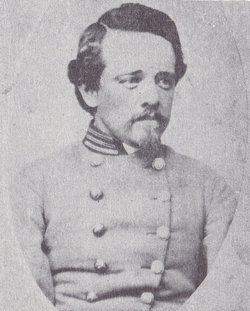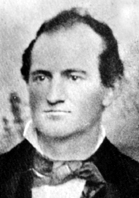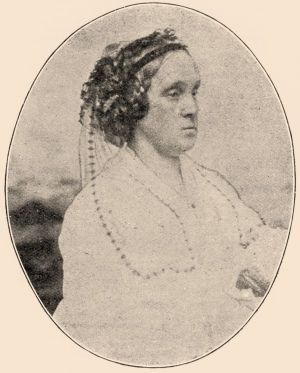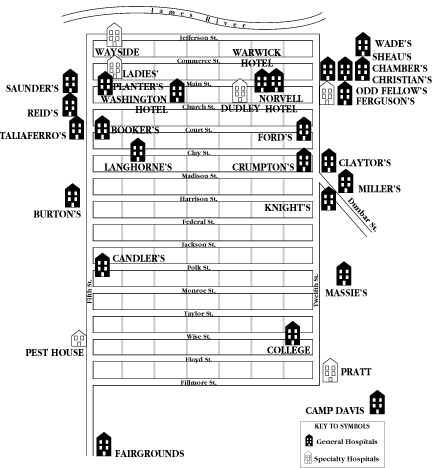
A Civil War Hospital Center
Lynchburg was known as “Tobacco Town” before the Civil War, with its 70 thriving tobacco businesses and numerous warehouses. It was also a railroad hub, the terminous of three railroads. Early in the Civil War, many of the warehouses were converted into hospitals and the railroads became the conduit for Confederate casualties pouring into the city. There was a peak time after the Battle of the Wilderness (May 1864) when Lynchburg, with 6,000 inhabitants, was overwhelmed with over 10,000 wounded and diseased soldiers. During the four year Civil War, as the South’s largest outpost hospital center, Lynchburg admitted in excess of 20,000 patients with nearly 3,000 deaths. Over 2,200 of those soldiers are buried in this Confederate Section of the Old City Cemetery.
Below you will find the location of the tobacco warehouses and Lynchburg’s other buildings which were converted for hospital use. Additional private homes, used as temporary hospitals, brought the total number of hospitals to over thirty.
Lynchburg’s Confederate Surgeons
Lynchburg’s hospital center was staffed with over 50 military surgeons reporting for duty from all parts of the Confederacy.
The War Department appointed Lynchburg physician, William Otway Owen, as Surgeon-in-Charge of Lynchburg’s large medical complex.
Another Lynchburg physician, Dr. Edward A. Craighill, entered the Army at seventeen, becoming the Medical Department’s youngest physician to serve. Craighill, who worked in the College Hospital, wrote of his incredible experiences after the war.
.
Dr. E.A. Craighill
Dr. John Jay Terrell, a Quaker from Bedford County, Virginia, served in Burton’s Hospital, reformed conditions in the infamous Pest House hospital, and with Dr. Craighill, cared for the many wounded Union soldiers who had been left behind at Sandusky after General Hunter’s retreat following the Battle of Lynchburg.

Dr. J.J. Terrell
Lucy Mina Otey and the Ladies’ Relief Hospital
The unsung and frequently unappreciated heroes of the Confederacy were the Southern women who worked in the hospitals. Mrs. Lucy Mina Otey, age 60 and a recent widow who eventually lost three sons in the Civil War, formed a corps of 500 Lynchburg women, the Ladies’ Relief Society, to make bandages and uniforms. As the carnage of war continued, women’s roles quickly expanded to becoming nurses and hospital matrons.
Greeted and rebuffed at a post hospital one day with the orders: “No more women, no more flies,” Lucy Mina Otey traveled to Richmond and petitioned President Jefferson Davis to establish the independent Ladies’ Relief Hospital on Main Street. With a capacity of 100 patients, the Ladies’ Hospital was staffed by the Women’s Corps with “Mrs. Captain Otey” as its President. Even though it became an unwritten law always to send the worst casualties to Ladies’ Hospital, their mortality rate was the lowest of the local military hospitals, and it became renowned as one of the finest hospitals in the South.

Mrs. Capt. Lucy Mina Otey
Crippled Corps and V.M.I. Cadets
Form Inner Defenses in the Old City Cemetery
Battle of Lynchburg, June 18, 1865
A week before the city of Lynchburg was to be invaded by 18,000 Union troops, the city lay vulnerable, unprotected by Confederate forces.
Brigadier General Francis T. Nicholls, a double amputee who had recovered in a Lynchburg hospital, organized a corps of convalescing Confederates from Lynchburg’s numerous hospitals to defend the city during that critical week.
Over 700 “cripple corps” manned the barricades along with 200 Virginia Military Institute cadets who had rushed to defend the city.
The initial line of inner defenses ran through this Old City Cemetery where V.M.I. cadets bivouacked for the night.
The cadets and convalescents protected Lynchburg until the Confederate Second Corps and other units arrived to repel the Union attack the next day.
Location of Civil War Hospitals in Lynchburg, Virginia

